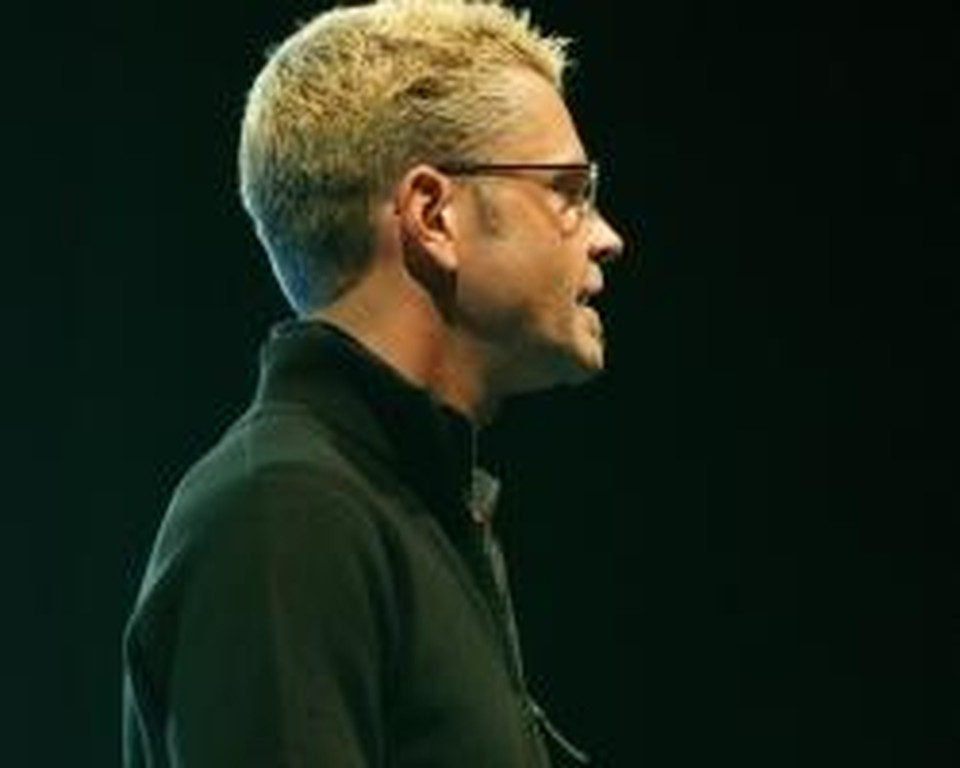Preaching in a Changing Culture: An Interview with Ron Martoia
After eighteen years as pastor of a church he planted, Ron Martoia's ministry has shifted to that of a "transformational architect," equipping leaders to deal with change.
Updated May 28, 2008

After 18 years as pastor of a church he planted, Ron Martoia’s ministry has shifted to that of a “transformational architect,” equipping leaders to deal with change. His speaking and writing seeks to help leaders understand a shifting culture and learn to minister effectively in an era of change. (You can visit his website at velocityculture.com.) He recently visited with Preaching editor Michael Duduit about what he is learning and how that can help preachers in an era of cultural transformation...
Preaching: In your book Static (Tyndale House), you use that term to argue that we have obscured the communication of the gospel in some way. What do you see as the problem with how we communicate the gospel today?
Martoia: You have absolutely captured the essence of that whole concept of Static. When I use a word, I am encoding that word with specific sorts of ideas – I am assuming that the kinds of things I am investing in its meaning are the sorts of things you extract from its meaning.
I actually used this is an illustration: If I used the word “barn,” in a sentence I obviously have all sorts of experiences and ideas and thoughts into me using that particular word “barn.” If those are positive experiences of growing up at Grandma’s farm and going into the barn and swinging on a great big tire from the rafters and jumping off into hay piles, then that is a pretty positive word and a pretty positive experience. But if by hearing me use the word “barn” you recall what was actually a tragic experience for you – perhaps you lost a loved one in a barn burning down – all of a sudden the sorts of idea and feelings, the intangibles that are conjured up in that word are definitely not what I am hoping it provokes in you when I use the word. So we have some static.
The issue that we are really being challenged with here is obviously something we talk about in preaching a lot. What I am investing the words with is what I am hoping you are getting out of the words, and if they are not the same it is up to me to communicate or to make sure that somehow I get that clarified.
When we move that concept into the arena of biblical communication or preaching, we’ve got an even harder complexity to face. Now not only do I have the material invested in your head and in my head of what the word might mean but we have how the world has defined a lot of our Christian nomenclature. As a result we often have got barriers to overcome that makes the language game more challenging.
Preaching: What do we do about that? How do we reclaim our own language and reframe it in such a way that we are accurately communicating the gospel?
Martoia: You’re tapping into the most important question. As I understand it there are a couple of solutions that we have. One is to do what you just mentioned – to take the language that we currently use and reclaim it. Let’s redefine that language so people are really clear of what we are saying, and rehabilitate it. That is one approach: to reclaim and rehabilitate.
I am not convinced that approach is very effective. Over the past number of years – and I am talking decades here – it seems like for all of our efforts to reclaim things we haven’t made much headway in public discourse. For instance, Ken Taylor came along in the late ’70s and develops the Living Bible that will not just reclaim the language but really actually alter the language. So two things happen. The hearer hears things that they may not have buckets or containers for – not have definitional phrases for – so that the author has the opportunity to help the reader along and redefine the language for the person.
This is exactly what we have with Eugene Peterson’s The Message. Instead of calling the book The Gospel he decided to call it The Message. This seems to be an illustration of the second tact: what if in our efforts to redefine this language so that people get it, we also use some different containers, some different buckets, so that we don’t have all the negative freight that we have to sort through before we finally get to the punch line.
Of course when this comes to preaching, if we had four hours on Sunday mornings to explain to people what we are trying to preach about that would be a rather lengthy task but we don’t have that. We are also swimming up stream tremendously when it comes to us thinking through how we communicate biblical concepts in this era – for example, when we might use the word “evangelist” and somebody’s got terribly negative connotations related to evangelist simply by what they see on T.V. So when we use different words, it is possible for us to communicate the concepts more clearly and quickly and not shut the conversation down before the conversation even begins.
Preaching: Moving past the concept of the use of language, do you believe that in many ways the church may sometimes be communicating not just using incorrect language but perhaps communicating the wrong concepts or the wrong reality?
Martoia: I think you are absolutely dead right. We don’t just have a semantic problem. What I have tried to articulate in Static and in its follow up volume (coming out soon) is that we have been telling an abbreviated message, a truncated message – a thin-sliced low-cal version of the message. In many cases, we may have a misunderstanding of the concepts that we are attempting to convey. As a result of that, at times we have been telling an abbreviated message of the Gospel that actually is more a construction of the modern world than it is a holistic understanding of the biblical world view. I think it is really important that we understand these terms we are using biblically and from a contextual standpoint before we even attempt to change the language and semantics of it.
Preaching: You also assert that what you call the “conventional church” is increasingly losing its hearing in the culture. What is behind that and how do we respond?
Martoia: This is a challenging issue, and I think in some ways preaching sits right in the center of it. Look at the way are architecture is set up in most churches and the way our learning models are set up. The American churches are in many ways in cahoots with the American education model, which is without a doubt a post-enlightenment project where we have a “sage on stage” that delivers the gemstones and we in the congregation sit and listen and nod our heads and say, “Yes, that is excellent,” and we walk away and say, “Good, I heard another message.”
The challenge that besets us is that for all the information we are delivering in a typical church on a weekly basis, it seems that there is a disproportionately small amount of life change. Some say there is an inversely proportional amount. If you come out of a traditional church context, you have Sunday morning, Sunday night, Wednesday night, get into a small group, do your own personal Bible study, read some Christian books. Take a look at the five, six, eight, ten, twelve, fifteen inputs we’ve got going into our life – we ought to be life change giants, we ought to be experiencing profound and deep transformation.
Yet guys like Gallup, Barna and Princeton Research all seem to indicate the amount of life change and the amount of transformation going on inside of us as Christ followers is hardly different from those who are not Christ followers. So something is amiss with the way information is being communicated or with the content of the information that is being conveyed. I think probably it is a little bit of both.
On the one hand, we probably have some concepts that are a bit dry and worn out; they’re ineffective. It may be that we have a ministry model that is engaging a small percentage of the people in terms of learning styles. You know, I love to sit and listen to lectures, but educational theorists say that there are only eighteen percent of us that like to listen to lectures. Most of us learn in totally different ways. What does that mean to the church? That means we have to start thinking about how we get people in a learning situation so they can experience life transformation, not just as a stream of information but somehow as information into action. That is going to be a monumental task in the next several decades.
Preaching: Let me press you a little bit at this point. The evangelical megachurch still seems to be growing dramatically. There you find what you’ve called the “sage on stage” surrounded by professionally done music and staging and all these kinds of things. It appears that a lot of the numerical decline is in the smaller church setting, which one would think would be a more conducive setting for community and some other types of learning models we are talking about. All the folks that are moving into these evangelical megachurches – do you argue they represent the last gasp of a dying culture, or are they just the eighteen percent? Or ignoring numbers, is it that people are still attracted to that model, but once they get there something is not happening that would have produced life change?
Martoia: Obviously when we ask those either/or questions we run the risk of being really reductionistic. I want to be careful to say that life change can happen in any context – big, small, preaching, not preaching, group dynamics, etc.
That said, you know I was a church planter and was in a large church for almost twenty years; I certainly understand the dynamics of that. We really do crave these experiential dimensions, and let’s face it, large churches often can create experiences that small churches simply don’t have. A church of a thousand has a very different sort of budget to yank off a great drama, a great media, a really awesome ambiance that a church of eighty or 200 simply doesn’t have. We aren’t even talking about mega, mega churches. You get into a church of five thousand or ten thousand and the stakes go up even higher.
Now am I suggesting that everyone is just flocking to churches because of its bigger glitz or bigger Hollywood? That wouldn’t be my conscious suggestion, but there is no doubt you are noting something that is real interesting. The middle seems to be disappearing. We either have a really small church or a really big one.
I think it is interesting to note there is a renaissance of home churches going on, along with some large, large churches. I think small church is that we really want community; we don’t care about the big, huge, overwhelming experience. Or you go to the large church and I will find community within this larger church in a smaller setting. Or smaller community isn’t as valuable to me, I just want the big experience. So can life change happen? I think it can. I am just not at all convinced that the big church is something that we will see last for the long term. I think it is going to end up being much more a product of modernity. A valuable chapter in church history maybe, but not something that has sustained power.
Preaching: As a pastor, you were one of those really creating the model for the multi-sensory experience. Tell me a little about the Encounter service you led.
Martoia: Encounter for us was just an amazing several-year experiment. What we committed to doing with Encounter was to monthly create a venue for anywhere from sixty to ninety minutes that was almost exclusively experiential and interactive. If we had any talking heads during the service itself it might be two to three minutes of instruction of where we were headed next. Almost everything else in the sixty to ninety minutes was done either by questions posed on a screen or video direction; I don’t mean a talking head on a screen, I mean questions posed or experiential opportunities given: poetry, things that enabled people to come in and immerse.
The immersion part was mostly environmental. Sometimes we did this with no chairs in our auditorium, sometimes cushions, sometimes we were sitting in a big desert. I think that is the most well known example, where we brought in a ton-and-a-half of sand and created a dessert with cactus and everything. It might be where we created a huge reflecting pool in our auditorium and floated candles.
All of these environments that we created were really trying to help people connect a biblical theme to something they could experientially do. Usually there was some sort of artifact they could take home from the services – a polished stone, a piece of wood or a fragment from a painting that we had corporately painted, a piece of polished glass that was used to make a corporate mosaic or a square of clay they used to put their thumb print in to represent that they are God’s workmanship and unique, Ephesians 2:10. We always tried to have an interactive part which had communitarian dimensions and part which had very much individual dimensions.
I think what was most interesting was that our people were more apt to invite non-churched friends to Encounter than to Sunday morning. Sunday morning was usually very experiential. It had the ambiance, lights, bands, video and all that stuff. But the interactive, minimal talking head approach seemed to be a huge attraction for people who were not going to come to a conventional church service.
Preaching: Looking back on that experiment, was it overall a very positive venture – something that you would do again? And is there a downside?
Martoia: Oh yeah, it was an amazingly positive experience. Would I do it again? Sure. I think there are churches that are experimenting and continuing to do those sorts of things.
What’s the down side? The thing that is cool about Encounter is that, depending on what you are going to do, it is very scaleable. But the larger the church you get into the harder it is to do these things. To create this massive interactivity for a church of 5,000 is very different than doing it for a church of 500, for instance. Maybe the scalability gets increasably difficult as you get larger, whereas it is quite the reverse on the Sunday morning venue when you try to create immensely good video, excellent graphics. Those things require whole teams and sometimes editing platforms and cameras. In a church of 200 you don’t have the budget to pull something like that off, but they could probably pull of an excellent Encounter service that is highly immersive, very interactive, yet do it in a budget that it could easily be done.
But the challenge is how do we, on a weekly or monthly basis, engage an entire team of people that would be part of the creative process to help pull off immersive and interactive environments. It is hugely time intensive to pull off. It is one thing to pull off a well executed service that has good video and graphics. You can have a small team of people and yank it off and it can be amazing. If you want to do highly immersive environments and use multiple interactive elements, you either have to have a huge staff or have a cadre of volunteers that goes very deep numerically to pull of some of these events. Some of these events took several hundred man hours tearing down Sunday morning to get ready for the Sunday night monthly experience; it is immensely time intensive. That is the thing that is very daunting. How do you get creative teams activated? And how do you make sure you don’t burn them out, because it is so time intensive.
Preaching: One of the examples I have referred to in training events is the service with the food: the aromas, the use of the food commercials. I have described that to pastors as a way to appeal to other senses, getting people experientially engaged in whatever is done. Even pieces of something like that can be used in a traditional sermonic setting.
Martoia: That is a good example of one that is easily scalable, not expensive – a few bucks but not expensive. That particular encounter what we were referring to was “Hungry?” Some people might instantly make the spiritual connection, but it is not long after you start smelling food that people shift back to physically thinking “am I hungry?” Three minutes into the experience you are salivating, your stomach is roaring.
We are looking at video clips of these scrolling food commercials and we have a poetic reading that allows people to realize that at eleven o’clock at night when you see a Burger King commercial, you’re thinking, “I could go for a Whopper right now. I know it is eleven but I could eat.” The world does things like that to provoke hunger. What do we do to provoke hunger in each other to spiritual things? That was the secular/back to spiritual tie in.
Those sorts of tie-ins cause people to go, “I go throughout my day and the world is trying everything it can to get me to go buy its Big Mac. What do we do to each other to get us to press into God?” I think the other genius thing about Encounter is the team was able to make what appeared to be obtuse connections that ended up being very powerful and memorable.
Preaching: What do you think preaching is going to look like in the next generation, as we go through the kind of cultural changes now underway?
Martoia: I think my guess is as good as anybody’s! Homiletics was once three points and a poem. Now I think great preaching is going to do a couple of things. One is move away from giving pat answers. We’ll ask more profound, probing questions so that the hearer is able to engage the learning experience themselves, even though it is still dominantly rational and linear, deductive.
When my child comes asking for me to help them with algebra problem number eight and says, “Dad, can you give me the answer?” I say, “Yeah, here it is,” which is often what we do in preaching. But instead we can ask some really good questions, so that when it comes to number nine on the algebra worksheet they are not asking for the answer again, but applying the questions that I asked so they can come to some conclusions themselves. I think that is already becoming something that is highly valued.
Second, for lack of a better term, I think we are going to see more of an Oprah-fication of preaching, if I can be so crass, and venial. I think we are going to have to do far more of an interactive sort of speaking. The African American community does a much better job at this than we do in the Anglo community. I wonder if we don’t need much more interactive questions posed and popcorn answers given, almost conversational preaching.
Some people say that just isn’t practical. I understand why we say that, I recognize there are risks inherent in that, but I don’t know if the investigation of new preaching styles is nearly as risky as staying on the autopilot course we are on, which doesn’t seem like a very viable solution at all. Let’s do what we have always done and turn up the volume – that doesn’t seem like an effective solution at all.
I wonder if we are going to need to experiment with those sorts of changes, where we may make preaching in the postmodern age look fundamentally different from the modern world. Sage on stage, lecture – what will it look like? I think it might be a little different from that; we will see though.
We have piloted just a little of this. What happens when the typical speaker or narrative communicator walks out on stage, does a ten minute wind up, everybody has some conversation, perhaps have a computer terminal within the group of the six of them. They log in and give preliminary popcorn learning that is downloaded into a database. The sage on stage walks back out, shares some corporate learning that is being shared at the tables. This could be in a group of 100 or it could be a group of 10,000; it is doable. What would it be like if we kept technology not for glitz but for communication, so that we could really come to learn together and come to know together? I think those things hold some possible promise, at least for exploration.
Preaching: As we try to communicate the gospel within our own cultural context, how do we as communicators tell the difference between substantive cultural change and temporary trends? How do we avoid locking ourselves into what is going to be a very temporary trend?
Martoia: As you know that is always a danger. We may not always know the situation of a trend being a trend burning itself out. Later we say, “Oh, that was a trend.” The question that you are asking is: are there ways to discern on the front end if this is going to be something that is short-lived or maybe actually longer? That is something that is far more complex.
For example, when we take a look at what is going on as our modern world is shifting to a postmodern world – whatever exactly that means – I think what we are realizing is how knowledge is perceived. Increasingly people recognize that just because there is a bunch of supposed evidence for something to be true, lots of people are saying, “There might be evidence, but if it is not true in my experience I don’t care.” We could say that might be a trend.
Yet if we look around at culture not just in terms of epistemology – how we know what we know – but in terms of art, literature, architecture, when we look at others areas and venues of experience, what we find is the breaking of the same sort of rules is occurring. Is that an earmark that we are not just in a trendy avant-garde deal but maybe we are actually facing some sort of underlying change?
Beyond that, there are some things we have to seriously consider. We have to constantly think in the context of community – where we are really wanting to be all things to all men in order to win some. We really do want to do that. I think that means having diverse voices. My concern is that we end up having people of the same persuasions in the room so the outcome is going to be exactly the same. All the people that say we like seminary the way it is are the people in the seminary system that have a vested interest to keep the seminary system the same. That is not a helpful conversation, gang. We have to be careful with that.
The goal is not to become trendy. But, for instance, the language shift, to come back to Static. The language shifts that I am trying to propose are not language shifts for the sake of trends. They are language shifts because I think they get us closer back to what the New Testament and Old Testament writers were trying to evoke in us. What I would argue is that the kind of shifts being proposed there are really moving us back to a more biblical view. Many of the views that we are holding onto here are just long lasting trends that were very culturally-conditioned.
For instance, the four spiritual laws – we didn’t have it in the middle ages. That is culturally-conditioned – let’s extract it, let’s boil it down, let’s reduce it down, let’s point of sale it, let’s make it happen. For those who have come to Christ that way, thank you Jesus. But for us to say that is probably an enduring artifact, I doubt it. I think that it is probably something very modernistic and something that will pass with that era.
Your question is a complex one, but one that needs a lot of conversation. It only illustrates the very need I mentioned earlier: we have to do good semiotics. Semiotics is going to be at least part of the new hermeneutics; I don’t have any doubt about it.
We have got to be great exegetes of both culture and text. I think in seminaries we have been given the one. It has almost put the Bible in a place where we can’t exegete the text because we are not sure how to exegete the text into a culture that it can speak to. Let’s be as careful culturally as we are textually. I think if we did that we would be so much further down the road.
Originally published May 28, 2008.







